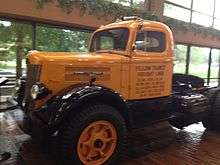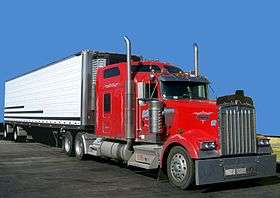YRC Worldwide
 | |
| Public | |
| Traded as | NASDAQ: YRCW |
| Industry | Transportation |
| Founded | 1929[1] |
| Founder | G.C. "Cleve" Harrell, A.J. Harrell |
| Headquarters | Overland Park, Kansas, USA |
Area served | Worldwide |
| Revenue |
|
|
| |
|
| |
| Total assets |
|
| Total equity |
|
Number of employees | 32,000 (2011)[2] |
| Subsidiaries |
YRC Freight YRC Reimer Holland Reddaway New Penn |
| Website | YRCW.com |
YRC Worldwide Inc. is the holding company for brands including YRC Freight, YRC Reimer, New Penn, USF Holland and USF Reddaway. YRC Worldwide has a comprehensive network in North America, and offers shipping of industrial, commercial and retail goods. The company is headquartered in Overland Park, Kansas.[2]
History
In 1906, Grover Cleveland “Cleve” Harrell (1884-1942) started what was to become the Yellow Cab Company with a horse-drawn hack and a team of horses in Oklahoma City. After a year, he bought a Model T Ford. People were willing to pay more to ride in an automobile. After World War I, he bought two more cars and hired a relief driver. In 1918, Harrell painted one of his cars yellow. Although ridiculed by other cab drivers, he was hauling more passengers than anyone else, so he painted all his cars yellow and business boomed. Harrell trademarked the name Yellow Cab in Oklahoma. Later, John Hertz copied the Yellow Cab in Chicago and obtained the national trademark for the use of the name.
Harrell’s older brother, A.J. Harrell (1883-1972), had followed him to Oklahoma City and had been successful in the operation of a horse and mule business during World War I. Cleve needed extra capital for expansion, so he formed a partnership with A.J. The company’s offices were moved to 113 S. Santa Fe, and their younger brother, Marvin Harrell, and their father, Jake Harrell, were added to the payroll. The partnership started a cross-country bus line connecting Oklahoma City and Tulsa, which was later sold to Pickwick Bus Company of Tulsa. Cleve established the Capital Hill Bus Lines for the southern part of Oklahoma City, which he successfully operated for several months before selling it to the Oklahoma Street Railway Company.
When oil was discovered in the Oklahoma City area, mules were needed for work in digging slush pits, so the Harrell brothers bought mules and, in 1929, established the Yellow Transit Freight Lines to serve small manufacturers for whom freight was slow and express rates were prohibitive. By 1933, with the New Deal and the NRA, most businesses came under government regulation in an attempt to increase employment. Cleve, together with taxicab operators from other parts of the country, met in Washington D.C. to formulate a regulatory code, which didn’t succeed. Cleve then devised his own code and got government confirmation.
About this time, the Harrell brothers dissolved the partnership. Cleve took the taxicabs in the trade-out, as well as the Yellow Cab Dynamic Gasoline Company. He sold the taxicab business in 1940 to Eddie Fuller, who operated the Y and Y Cab Co., and maintained ownership of the gasoline company until his death on December 3, 1942. A.J. took control of the freight lines, which he operated for many years. The company remained small until 1952, when an ownership group led by George E. Powell Sr. bought the freight company. During this time, Yellow helped pioneer the concept of consolidating small freight shipments into trailer loads.

In 1968, the company name was changed from Yellow Transit Freight Lines to Yellow Freight System Inc. During the deregulation of interstate trucking in the 1980s, Yellow Freight System embarked on a massive restructuring by creating new distribution centers across the country to better serve customers. The company changed its name to Yellow Corporation in 1992, when it created a parent company, with Yellow Transportation, Inc. as its largest division.
In December 2003 Yellow Corp. acquired Roadway Corp. for $1.05 billion, forming Yellow Roadway Corporation. The merger more than doubled revenue; Yellow Corp. posted a 2003 revenue of $3.07 billion, and Yellow Roadway Corp. had a 2004 revenue of $6.8 billion. These revenues continued to increase with the $1.5 billion acquisition of USF Corp in 2005. to a high of $9.9 billion in 2006. These increases also saw jumps in profit, which increased from $40 million in 2003 to $184 million in 2004 to a high of $288 million in 2005. Yellow Roadway Corp. also made forays into the international market, particularly China. In September 2005, the company purchased half of Chinese freight-forwarding company JHJ International Transportation Co. Ltd. and in August 2008, bought a 65 percent share of Chinese Shanghai Jiayu Logistics Co.
YRC reported a net loss of $976 million for its 2008 fiscal year. In 2009 it again reported a net loss of $622 million. Towards the end of 2009, YRC narrowly averted having to file for bankruptcy protection by successfully persuading its bondholders to exchange their $470 million in bond notes for roughly 94% of the company’s shares. Concurrent with more recent manufacturing sector growth and recovery, since the fourth quarter of 2009, YRC has again been approaching a net positive balance sheet.[3] Nonetheless its share price declined in year 2010 more than 80%, raising in 2011 suspicions of Death spiral financing.[4] In September 2011 the company completed a financial restructuring that has essentially wiped out any shareholder equity.[5]
On March 1, 2009, Yellow Transportation and Roadway formally merged to create YRC Inc. DBA as YRC Freight starting in 2012.
On December 15, 2011 YRC Worldwide sold a significant portion of Glen Moore including the Carlisle, PA terminal to Celadon, located in Indianapolis, IN
Color
In 1929, A.J. Harrell enlisted the help of E. I. du Pont de Nemours and Company to improve highway safety by determining the vehicle color that would be the most visible on the nation's highways. After the review was completed, it was determined that the color of the Swamp Holly Orange would be most visible from the greatest distance. Swamp Holly Orange became the color used on all company tractors.[6]
Image gallery
-

Vintage Yellow Corporation logo
-
.jpg)
Restored 1939 Mack Truck and trailer
-

Restored 1948 White road tractor model WC-22T
References
- ↑ http://www.edumaritime.com/transport-logistics-career/yrc-worldwide-inc-yrcw
- 1 2 3 4 5 6 7 "YRC Worldwide, Form 10-K, Annual Report, Filing Date Feb 28, 2012" (PDF). secdatabase.com. Retrieved Feb 16, 2013.
- ↑ Twiddy, David (March 16, 2010). "YRC Worldwide reports a fourth-quarter profit....". Retrieved 2010-03-27. Financial summaries of YRC books, 2008 - 2009
- ↑ "YRC Worldwide - A Calculated Risk". February 15, 2011. Retrieved 2011-05-22.
- ↑ "Big time losers and the reasons why". September 16, 2011. Retrieved 2011-09-19.
- ↑ http://www.myyellow.com/dynamic/services/content/serviceguide/fyi/truckcolor.jsp
